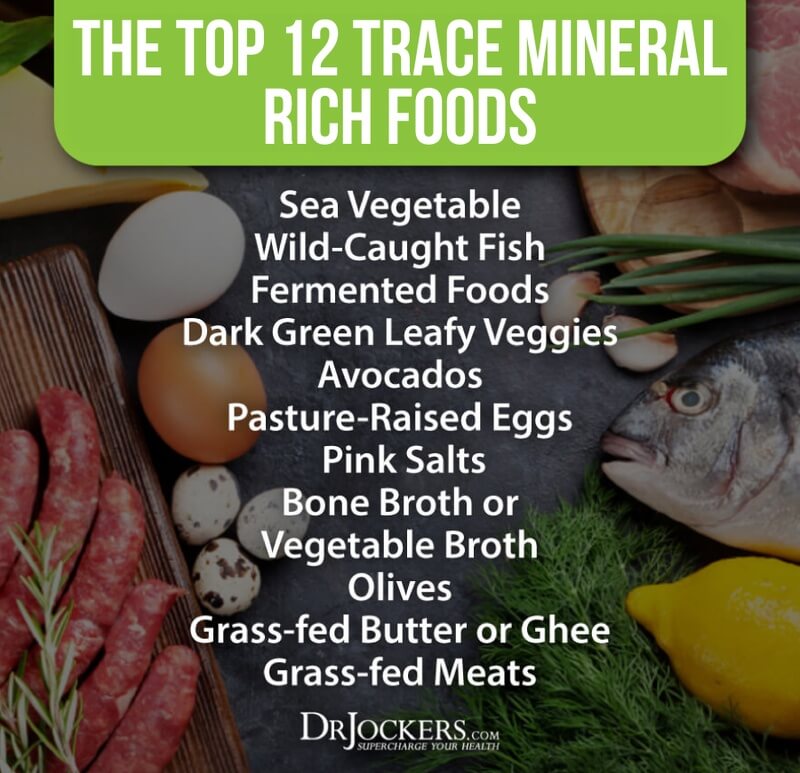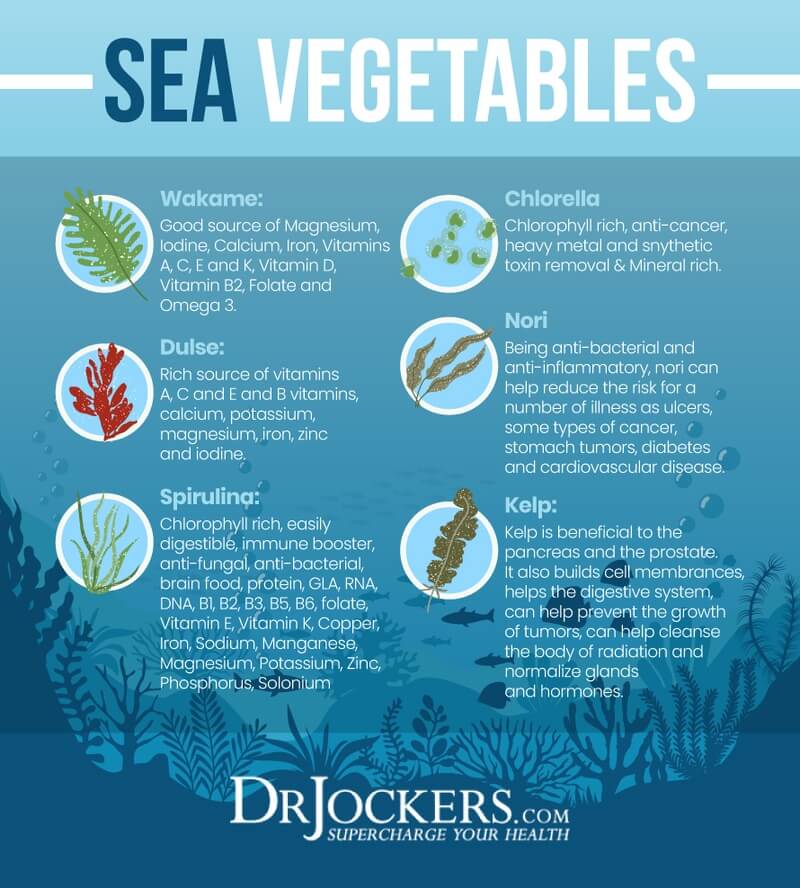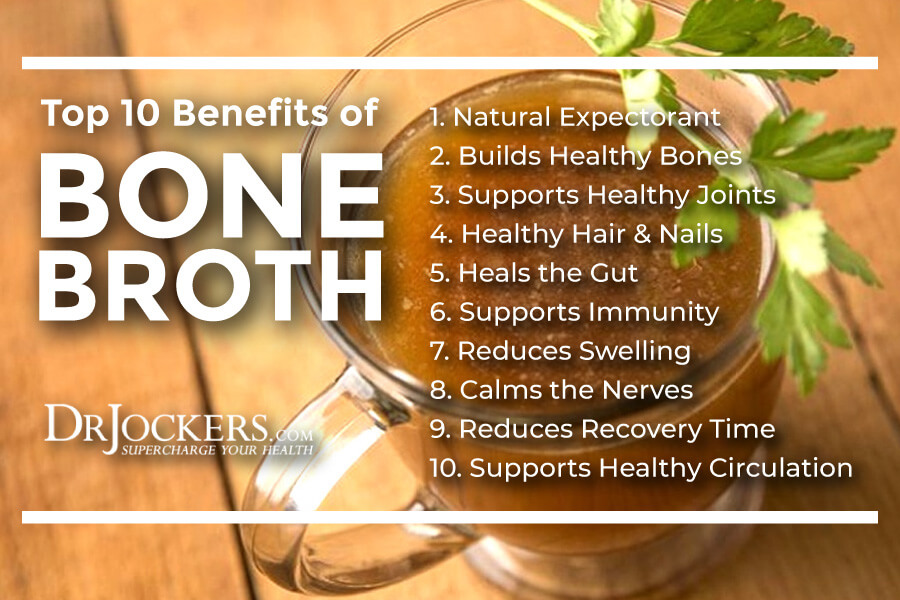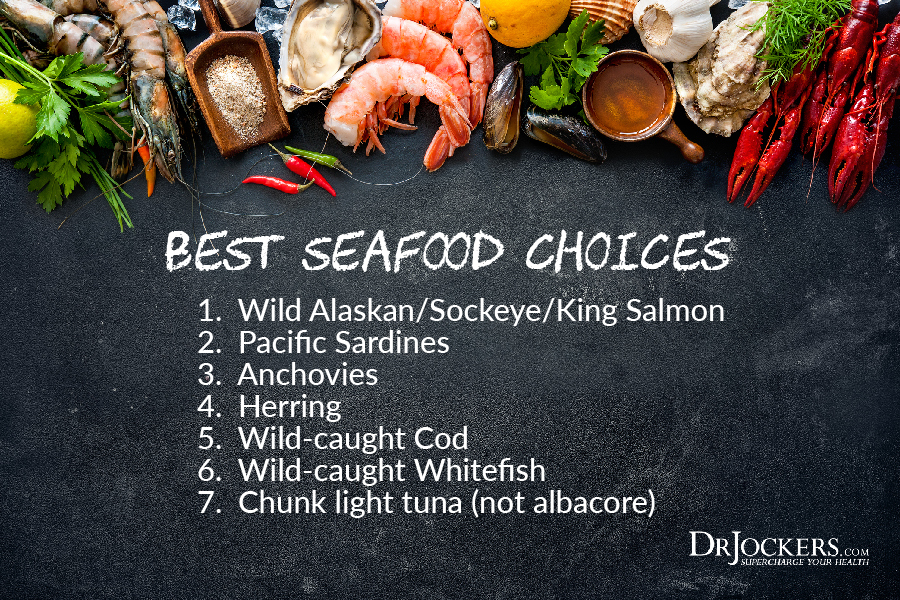 Top 12 Trace Mineral Rich Foods
Top 12 Trace Mineral Rich Foods
As knowledge of how to live a healthy and nourishing life becomes more mainstream, we have more people who understand the importance of different nutrients in the diet. Something that needs more attention in my opinion is the importance of trace mineral rich foods in the diet.
These are minerals that are required in very small amounts yet serve vital roles in our health. In this article, I will go over the top 12 trace mineral rich foods to include in your diet!
While there are many sources of trace minerals, many people simply do not consume them. At the same time, negligence of responsible farming practices has largely disturbed the natural mineral balance of our soils. This makes it even more important now more than ever to ensure that you consume a variety of trace mineral rich foods.

The Roles of Trace Minerals
Trace minerals are needed in very small amounts, typically less than 100 milligrams per day is enough to meet daily requirements. That being said, we still must acquire these things from our diet in order to achieve optimal health.
The most important of these minerals include iron, iodine, cobalt, chromium, copper, zinc, manganese, selenium, and molybdenum. One of the large roles of trace minerals is to enable enzymes to complete reactions in the body. This means they assist in a wide array of biochemical processes that are always occurring in the body.
Adequate mineral intake is required for energy production; building new blood, bone, and hormones; having a strong immune system; and much more.
Not only do we need to acquire these things nutritionally, but we must have some level of competence in knowing the amount that we are getting. Similar to the relationship between omega 3 and omega 6 fats, different minerals are the most health-promoting when not consumed in inadequate or excess amounts.
Top 12 Trace Mineral Rich Foods
There are reasons that supplementing with trace mineral rich foods may be a good idea. In a second I will discuss how certain people may have an even higher need for trace minerals, but first these are the top 12 trace mineral rich foods to include in your diet on a regular basis to help ensure you are not deficient.
Personally, I believe the best strategy is to incorporate several of these trace mineral rich foods into your diet on a daily basis to ensure that you are obtaining a variety of trace minerals in different ratios instead of heavily relying on one or two for all your needs.

Sea Vegetables
Sea vegetables are one of the most powerful yet overlooked sources of trace minerals. These include things like kelp, dulse, nori, and wakame. These can be used in soups, in Asian-inspired dishes, or even as a seasoning (like this one). Sea vegetables tend to contain an array of trace minerals, but are a particularly great source of iodine.
Some of the most nutritionally complete foods on the planet also happen to be sea vegetables. These include chlorella and spirulina. I would recommend finding a brand that grows these powerful foods in a clean, controlled environment that also tests for any heavy metal contamination (such as this one). Chlorella and spirulina contain a wide range of vitamins, minerals, omega 3 fatty acids, and even can be a good source of protein.
Sea vegetables have been researched for benefits to a variety of human ailments (1). My whole family enjoys these sea snax on a regular basis. These taste great and are super rich in trace minerals and chlorophyll!!

Wild-Caught Fish
In addition to sea vegetables, wild-caught fish are also very good sources of trace minerals. Oftentimes fish consume plenty of algae as a staple in their diets which is likely why they are so nutrient-dense. One of the absolute best fish you can eat is wild-caught sockeye salmon.
Salmon contains high amounts of selenium, phosphorus, and iodine. In addition to vital trace minerals, salmon also contains high amounts of Vitamin D, Vitamin B12, omega-3 fatty acids, and choline. This array of nutrients make salmon a super anti-inflammatory brain food.
Other great fish options include wild caught sardines, herring, and wild cod.
Fermented Foods
Fermented foods such as sauerkraut, pickles, and kimchi can be excellent sources of trace minerals. These foods contain trace minerals and the process of fermentation makes these nutrients highly absorbable.
An important factor to consider is the mineral density of the salt used to make these fermented products. By using a mineral-rich salt (such as this one) you can actually make these foods even more nutritious. The combination of probiotics, biologically-active enzymes, and highly absorbable minerals make these fermented foods a great option to meet your trace mineral needs.
Check out my simple recipe for some tasty fermented veggies here: Homemade Fermented Veggies.

Dark Green Leafy Veggies
Out of all vegetables, leafy greens are likely the most nutrient-dense when it comes to trace minerals. For example, kale is a great source of magnesium, phosphorus, potassium, copper, and manganese. Bok Choy is an underdog superfood featuring a significant array of nutrients including potassium, manganese, and magnesium. Lightly steam these and top with plenty of grass-fed butter (another great source of trace minerals, more on that in a moment).
Other incredible sources include arugula, collard greens, spinach, and Swiss chard. Consume some of these superfoods every day if possible. If you follow a low-oxalate diet, it is best to steam these foods lightly before consuming to help lower oxalate content.
Another great and convenient option is to utilize a high-quality greens powder that features things like leafy greens and organic grass juices as these can be great sources of trace minerals as well.

Avocados
Avocados are one of my favorite foods for two main reasons: versatility and nutrient density. Many people don’t realize this but avocados are a lot more than just delicious fatty fruits. This green fruit contains trace minerals magnesium, potassium, iron, and copper.
Additionally, avocados are rich in healthy fats, B vitamins, Vitamin K, and fiber. In fact, for someone following a ketogenic diet, avocados are one of the best foods you can possibly eat to ward of keto-flu and keep the bowels moving. You read about my favorite 8 ways to use avocados here.

Pasture-Raised Eggs
Factory farming practices have made once-healthy foods severely depleted of nutrition. Luckily, awareness is growing about this fact and farmers are making the effort to continue to uphold traditional farming practices. Eggs are incredibly healthy for most people, it is critical that you only consume eggs from chickens who were raised on organic pastures.
Eggs from these chickens are drastically higher in nutrients which is apparent by the dark color of the egg shells and yolk. Eggs are a great source of the trace minerals selenium and phosphorus in addition to healthy fat, cholesterol, active vitamin A, and Vitamin D.
Contrary to claims we’ve been fed for years, eggs from pastured chickens can help to reduce your risk of heart disease, improve eye health, assist in weight loss, and improve brain health. This is due to its wide array of nutrients, essentially making it a natural multi-vitamin supplement (2).

Good Salts
Traditional table salts are a chemically synthesized and isolated form of sodium chloride (NaCl). Naturally occurring salts from the earth such as Himalayan or Celtic sea salt contain an array of over 80 different minerals in trace amounts. These include phosphorus, zinc, manganese, silica, along with many others.
The commonly held belief is that too much salt will raise blood pressure. In reality, consuming natural salts can actually help to stabilize blood pressure by providing the minerals needed to help regulate fluid balance in the tissues of the body.
If you crave salty foods, this can be an indicator that you are in need of more trace minerals. Adding a high-quality salt to your foods and water can be an excellent way to increase trace mineral intake.
Bone Broth and Vegetable Broth
Making broth from trace mineral-rich foods is a great way to concentrate these nutrients into an easily-absorbable form. Broth made by boiling down the bones of pasture-raised animals contains calcium, phosphorus, magnesium, and potassium. Additionally, bone broth contains collagenous compounds that help to heal the gut and improve digestion (a common problem causing trace mineral deficiency).
If you are a vegan or vegetarian (or want to boost your bone broth further), you can obtain similar benefits by creating a broth using trace mineral-rich vegetables. Try simmering down a combination of sea vegetables, leafy greens, mushrooms, turmeric root (fresh), onions, garlic, ginger, and whatever other vegetables you’d like to add. Strain and you have yourself a mineral-rich broth.

Olives
Olives are underrated, point blank. These tiny oily fruits are loaded with antioxidants, healthy fats, copper, calcium, and magnesium. Another lesser-known fact, olive leaves are a potent anti-viral agent. In fact, olives and its associated products have been investigated for a long list of therapeutic properties ranging from fighting cancer to improving heart health (3).
The benefits of olives include improving cholesterol levels, lowering blood pressure, lowering diabetes risk, helping to fight infection, and even helping to prevent bone loss in osteoporosis.
For trace mineral benefits, it is best to consume olives in their whole form. While olive oil preserves some of the antioxidant properties of olives, most of the trace minerals are retained in the fruit.

Grass-Fed Butter
Something I’ve emphasized for a long time is the importance of consuming meat and dairy from pasture-raised sources. Dairy particularly can be an excellent source of trace minerals as long as the animal was raised consuming plenty of grass rather than genetically modified grains.
The dairy produced by pasture-raised, grass-fed cows is significantly higher in a wide array of nutrients. Consuming grass-fed butter or ghee on a regular basis can help improve trace mineral levels such as selenium, magnesium, zinc, copper, and iodine. Additionally, the compounds in grass-fed butter are anti-inflammatory, fat-burning, gut-healing, and brain-building.

Grass-Fed Meats
Similar to the dairy produced by grass-fed animals, the meat of grass-fed animals is much higher in trace minerals compared to conventional meat.
Grass-fed beef is a great source of selenium, zinc, phosphorus, potassium, magnesium, and copper.
Grass-fed lamb is another great option, offering significant amounts of the same trace minerals available in beef. Other meats to try include bison, elk, dark-meat poultry, and venison.

Reasons You May Need More
There are several circumstances that will increase your need for trace minerals:
Poor Gut Absorption: If you have chronically inflamed and damaged the structures of your gut then you will be absorbing less nutrients from the foods you eat. It is absolutely imperative that you address things like leaky gut, low stomach acid, and poor digestion to actually pull beneficial nutrients from the foods you eat.
Diarrhea/Vomiting: If you are acutely ill with diarrhea and vomiting, your needs for trace minerals will increase as you expel them from your body.
Phytates: Grains and legumes are high in compounds called phytates. These compounds are irritating to the gut and bind to minerals in the digestive tract which prevents your body from absorbing them. If you consume these foods on a regular basis, it is likely that you will need higher amounts of trace minerals in your diet.
Strenuous Exercise: If you are extremely active, engaging in strenuous exercise on a regular basis, it can be helpful to increase your mineral intake.
Metal Detox: Detoxing heavy metals is a strenuous process. Many Binders commonly used for metal detox tend to also bind with minerals, increasing your need. When undergoing a heavy metal detox, replacing minerals can be very helpful.

Supplemental Minerals
While foods are certainly the preferred source for trace minerals. There are cases in which supplementing with additional minerals can be extremely beneficial. While there are a multitude of products available, many just don’t meet my standards for bioavailability and overall utility.
This best product I have found is CT Minerals. This product contains naturally occurring, highly refined and naturally chelated extracts of Fulvic Acid.
This means ultra small-sized and ultra-low-molecular-weight 100% organically complexed nano-sized negatively charged ionic molecules which can penetrate human tissue and blood cells easily. Because of these unique properties, this supplement is highly bioactive and can provide numerous biochemical and metabolic detoxification functions.
In addition to containing over 70 naturally occurring, plant-derived trace element minerals, it contains highly bioavailable forms of magnesium. It is the most rare and valuable of all humic substances known to man. This supplement supports detoxification, energy, focus, and alertness. I recommend 1-2 capsules, 1-2 times daily.
Summary
Trace minerals, although only needed in small amounts, play vital roles in general well-being. Certain foods can be valuable sources of these nutrients, however there are special cases in which trace mineral needs are increased and supplementation should be considered.
Look to get more of these trace mineral rich foods into your daily nutrition plan. Drop us a comment in the box below to let us know which of these is your favorite!
Inflammation Crushing Ebundle
The Inflammation Crushing Ebundle is designed to help you improve your brain, liver, immune system and discover the healing strategies, foods and recipes to burn fat, reduce inflammation and Thrive in Life!
As a doctor of natural medicine, I have spent the past 20 years studying the best healing strategies and worked with hundreds of coaching clients, helping them overcome chronic health conditions and optimize their overall health.
In our Inflammation Crushing Ebundle, I have put together my very best strategies to reduce inflammation and optimize your healing potential. Take a look at what you will get inside these valuable guides below!








Thanks for the information. So much stuff out there don’t know what to believe.
Yes use these foods and you will notice an improvement in your energy and health!
everybody has a conscience, when you follow him your great!
The trouble with your recommendations is that you need a large income. Some of us just can’t afford healthy eating.
I do the best I can within my budget, but I won’t look for grass-fed anything.
Food prices are sky-high where I live.
R.
Just got to do your best Robyn! Blessings to you!
Hi Robyn, I would suggest trying to go directly to the source for grass-fed meats and/or dairy. And use the meat as a side dish and for flavor, instead of the meat being the main part of the meal. I think it is better to eat a little GOOD grass-fed meat than a lot of grain-fed, feedlot meat.
Although I have my own beef at times and now have my own lamb, when I don’t have my own, I can get grass-fed beef from a nearby farmer. I go for the stew beef and burger as they are the least expensive per pound, but the meat is just as good (and good for me) as fancy steaks. I can also get bags of bones for a very reasonable price for making bone broth.
I mail order cheese from a 100% grass-fed, organically-managed dairy in Pennsylvania, since I don’t have a cow right now and am not making cheese. The cheese is delicious and it’s a great price.
If you have no idea where to find farmers you could buy from directly, I would ask at any store that is health-related or make connections at farmers markets.
Several years ago, due to a family emergency, I unexpectedly ended up in a different state for several months. It seemed there was no way to access the healthy food I was used to, but I was determined to ferret out some sources. Within a very short time – a couple weeks – I was buying most all the things I can get here at home, just by asking around – organic raw milk, organic pasture-raised chickens… I found a co-op/buying club like the one we have here at home, for ordering bulk health food items.
All this to say that if you put your nose to the ground, you may be able to find and afford more than you might think. Also, just remember that contrary to American culture, meat doesn’t need to take up half the plate.
Thanks for sharing Deanne!!
Hi, Dianne!
I don’t have the energy to put my nose to the ground…it’s all so overwhelming, as I’m dealing with phase 3 adrenal fatigue at 73, but thank you for your reply.
Robyn,
I suggest you cut back on other things to save money, but I wouldn’t cut back on good food as good food will save you money in the long run as you’ll have much lower doctors bills. And you can find plenty of good food that isn’t all that expensive so concentrate on them rather than the more expensive good foods. For example, don’t buy fresh wild salmon fillets for $20 a pound when you can buy it in a can for $3 a pound. Another idea would be to somehow increase your income so you can afford more good food.
Thank you, John…I have HPA -axis dysfunction, aka adrenal fatigue, thus unable to work. I barely have enough energy to cook and shop for myself, but your suggestion of wild salmon in a can is excellent.
Hi Dr
I am becoming such a fan – so informative and motivational. I love the slides.
One question – I see your list of Best Seafood – can tinned mackerel fillets be included in this list – much prefer them to sardines and they are very inexpensive to buy in the UK.
Thank you
Yes you can do those Gisele! Blessings to you!
I get the best of both worlds for the bone broth and vegetable broth. I make my own broth by simmering chicken’s feet for about 24 hours in a crockpot. (After straining off the broth, I add more water to cover the remaining feet, simmer them for a couple of more days to make the bones and claws totally soft, and give them to a friend whose dogs absolutely love it.) Then I toss some regular chicken meat into the broth along with pretty much the same ingredients as Dr. Jockers lists for the vegetable broth plus a few more depending on what I have in the fridge that is getting a bit old. I always include some kelp leaves cut up into quarter-inch squares and spices like rosemary, oregano and thyme. I usually also toss in a handful of egg noodles because I need the extra calories to keep from loosing weight. I cook until the chicken, noodles and fresh veggies like carrots are done. Et voila, I have enough trace mineral-rich chicken soup to last me for a couple of weeks. I salt and pepper to taste when serving, making sure to get plenty of pepper to increase the bio-availability of the curcumin in the turmeric. Usually I’ll serve it with olives, avocado and gouda cheese, providing plenty of healthy fat to increase the absorbability of the curcumin. Heat up the soup, add some home-fermented veggies on the side, and I have my entire main meal of the day ready to eat in a matter of minutes.
Hey Greg, That is great! Thanks for sharing your recipe! Blessings!
HOW LONG WILL IT TAKE FOR ALL DOCTORS TO BE PROPERLY EDUCATED SO THEY CAN STOP PRESCRIBING DRUGS BUT PRESCRIBING KNOWLEDGE ABOUT EATING THE RIGHT FOODS FOR A SPECIFIC CONDITION? WHEN WILL MEDICAL INSURANCE PLANS INCLUDE SUPPLEMENTS AND COVERAGE OF ALTERNATIVE MEDICINE? NONE OF THIS SYSTEM MAKES ANY SENSE.
DR. JOCKERS IS EXCELLENT BUT THERE IS NO DOC AROUND HERE WHO EVEN KNOWS OR CARES ABOUT EVEN 10% OF THIS MATERIAL. IT’S SHAMEFUL THAT WE PAY FOR THESE PLANS BUT ALTERNATIVE DOCS AND SUPPLEMENTS WE PAY OUT OF POCKET FOR
Yes we absolutely need to change our current system!
As long as it takes for big pharma to go out of business is my guess..
I would just like Robyn to know that you can eat very healthfully on a vegan diet. I do not miss meat or dairy at all. I’m 76. Legumes and vegetables are inexpensive and there are a wide variety of both. Shop the produce department or your local farmer’s market and your grocery bill will be much less. You don’t need grass fed meat. You can eat greens directly.
Robyn,
The only expensive item I buy is the Ezekiel bread with sesame seeds. It is so nutrient dense. You can eat it with tofu, hummus, avocado, or natural peanut butter. Along with lentil soup or a salad of mixed greens and you have an inexpensive healthy meal. Also sweet potatoes fill you up without costing a lot.
Just make your focus legumes and lots of vegetables.
Thank you so much for a great and very helpful article. I was wondering if Ghee was as healthy as butter. I was also wondering if you could suggest any articles that you have written concerning carbohydrate intolerance. Since my mid 20’s ( I’m 75 now) I cannot eat starchy foods, sugar etc. I have to keep my carbs around 30 per day otherwise the next morning it feels like a hangover. I am of normal weight and am not a diabetic. Thank you so much for educating us on healthy eating.
Yes ghee is wonderful! Typically with people with carb intolerance, we need to focus on improving gut health, building muscle mass and getting a lot of movement in. Here is a helpful article: https://drjockers.com/balance-blood-sugar/